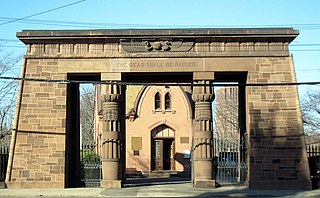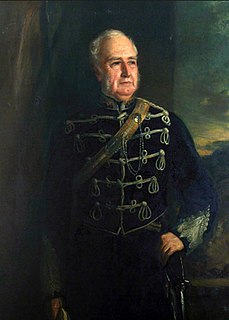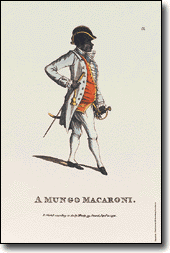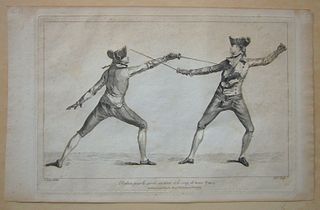
Henry Charles Angelo the Younger (1780-1852) was a British master of fencing, part of the Angelo Family of fencers.

Henry Charles Angelo the Younger (1780-1852) was a British master of fencing, part of the Angelo Family of fencers.
Henry was born in 1780 [2] to Henry Angelo (1756-1835). He was the grandson of Domenico Angelo Malevolti Tremamondo (1716 or 1717 to 1802), the founder of the dynasty.
The younger Henry took over his father's fencing academy in Bond Street from his father in 1817. He subsequently moved it to St. James's Street (1830-1896). He was superintendent of sword exercise to the British Army and the Royal Navy (1833-1852).
Henry died in 1852. He is buried in Kensal Green Cemetery. [2]

Kensal Green Cemetery is a cemetery in the Kensal Green area of the Royal Borough of Kensington and Chelsea in London, England. Inspired by Père Lachaise Cemetery in Paris, it was founded by the barrister George Frederick Carden. The cemetery opened in 1833 and comprises 72 acres of grounds, including two conservation areas, adjoining a canal. The cemetery is home to at least 33 species of bird and other wildlife. This distinctive cemetery has memorials ranging from large mausoleums housing the rich and famous to many distinctive smaller graves and includes special areas dedicated to the very young. It has three chapels, and serves all faiths. It is one of the Magnificent Seven cemeteries in London.

William Blackwood was a Scottish publisher who founded the firm of William Blackwood and Sons.

Grove Street Cemetery or Grove Street Burial Ground is a cemetery in New Haven, Connecticut, that is surrounded by the Yale University campus. It was organized in 1796 as the New Haven Burying Ground and incorporated in October 1797 to replace the crowded burial ground on the New Haven Green. The first private, nonprofit cemetery in the world, it was one of the earliest burial grounds to have a planned layout, with plots permanently owned by individual families, a structured arrangement of ornamental plantings, and paved and named streets and avenues. By introducing ideas like permanent memorials and the sanctity of the deceased body, the cemetery became "a real turning point... a whole redefinition of how people viewed death and dying", according to historian Peter Dobkin Hall. Many notable Yale and New Haven luminaries are buried in the Grove Street Cemetery, including 14 Yale presidents; nevertheless, it was not restricted to members of the upper class, and was open to all.

Charles Shaw-Lefevre, 1st Viscount Eversley, GCB, PC, was a British Whig politician. He served as Speaker of the House of Commons from 1839 to 1857. He is the second-longest serving Speaker of the House of Commons, behind Arthur Onslow.
William Henry Smith was a British entrepreneur whose business included both newsagents and book shops. He was born in Little Thurlow, Suffolk, but ran his business in London, where he died. The family business evolved into the chain W H Smith.

Thomas Turton was an English academic and divine, the Bishop of Ely from 1845 to 1864.

Julius Soubise was a freed Afro-Caribbean slave who became a well-known fop in late eighteenth century Britain. The satirized depiction of Soubise, A Mungo Macaroni, is a relic of intersectionality between race, class, and gender in eighteenth century London. His life of luxury as a free man of color allowed him to excel in elite activities such as fencing and made him notorious in London’s social scene as an exception to norms.

Lady Mary Fox was an illegitimate daughter of King William IV of the United Kingdom by his mistress Dorothea Jordan. In later life she became a writer.

Alfred Hutton FSA was a Victorian officer of the King's Dragoon Guards, writer, antiquarian and swordsman. He originated the first English revival of historical fencing, together with his colleagues Egerton Castle, Captain Carl Thimm, Colonel Cyril Matthey, Captain Percy Rolt, Captain Ernest George Stenson Cooke, Captain Frank Herbert Whittow, Sir Frederick and Walter Herries Pollock.
Colonel Daniel Mackinnon was a Scottish Colonel of the Coldstream Guards who played an important part at the Battle of Waterloo.

Henry John Gauntlett was an English organist and songwriter known in British music circles for his authorship of many hymns and other pieces for the organ.

Cadwallader Davis Blayney, 12th Baron Blayney, styled The Honourable from birth until 1834, was an Irish nobleman and politician.

Domenico Angelo, was an Italian sword and fencing master, also known as Angelo Domenico Malevolti Tremamondo. The son of a merchant, he was the founder of the Angelo Family of fencers. He has been praised as "the first to emphasize fencing as a means of developing health, poise, and grace. As a result of his insight and influence, fencing changed from an art of war to a sport."
There is some evidence on historical fencing as practiced in Scotland in the Early Modern Era, especially fencing with the Scottish basket-hilted broadsword during the 17th to 18th centuries.

Peter Rouw II was a London-based sculptor specialising in bas-reliefs in marble, often in the form of mural church monuments, and in wax miniature portraits, often of a pink hue on black glass. He designed medals, including one of William Wilberforce, and also made a few marble busts. He exhibited at the Royal Academy of Arts. In 1807 Rouw was appointed modeller of cameos and gems to the Prince Regent.
George Frederick Carden was an English barrister, magazine editor and businessman, credited with the development of the garden cemetery movement in Britain and the foundation of London's pioneering example: Kensal Green Cemetery.
Charles Whittingham (1795–1876) was an English printer, a nephew of Charles Whittingham (1767–1840) who took over the Chiswick Press from his uncle.
Charles Ross (1799–1860), was a British politician, Member of Parliament for Orford (1822-1826), St Germans (1826-1832) and Northampton (1832-1837).
The Art of Defence on Foot was first published in 1798. It is a detailed manual of instruction for British military infantry swordsmanship. It is the oldest known British manual intended to teach purely military swordsmanship on foot. Four editions were printed between 1798 and 1824, the first three in London, UK and the last in New York, USA.

Henry Charles William Angelo (1756–1835) was an English memoirist and fencing master, as a member of the Angelo family of fencers and son of the Italian master, Domenico Angelo.